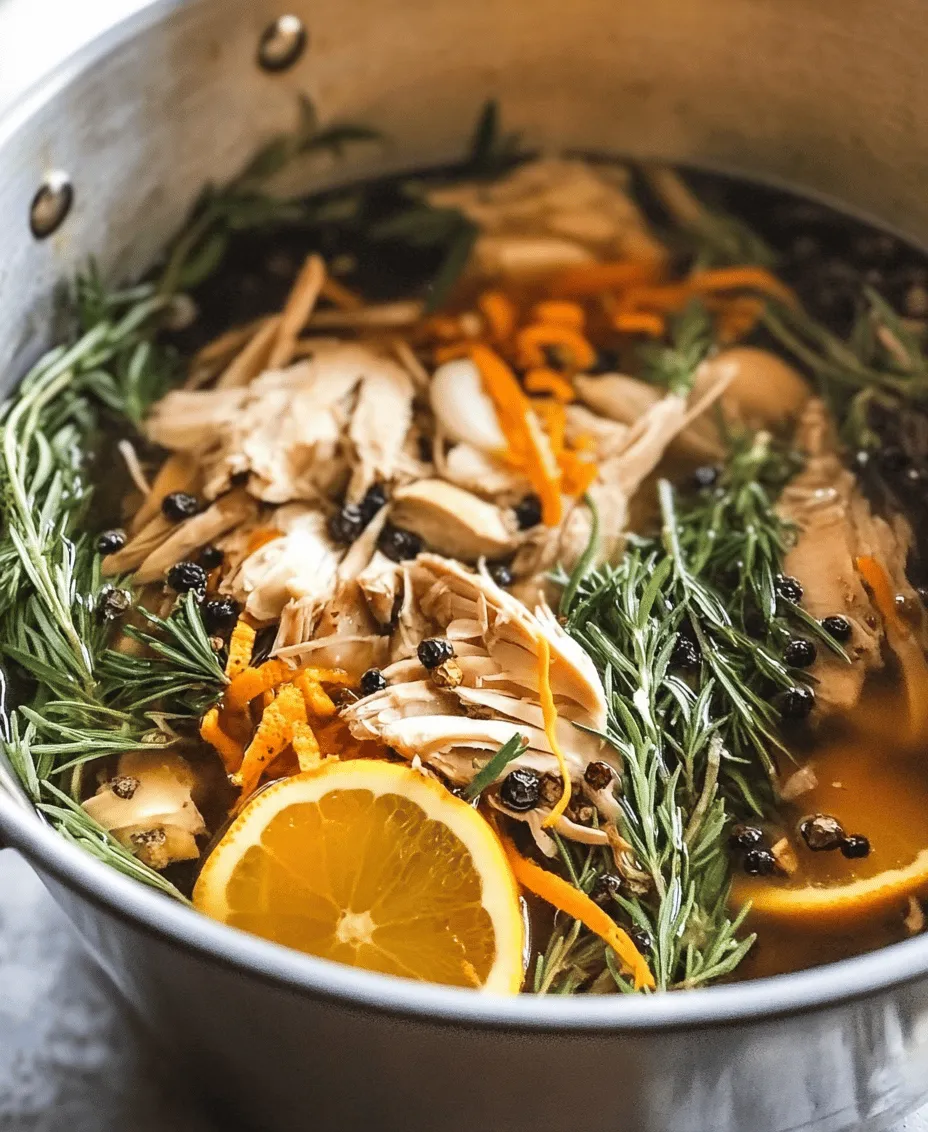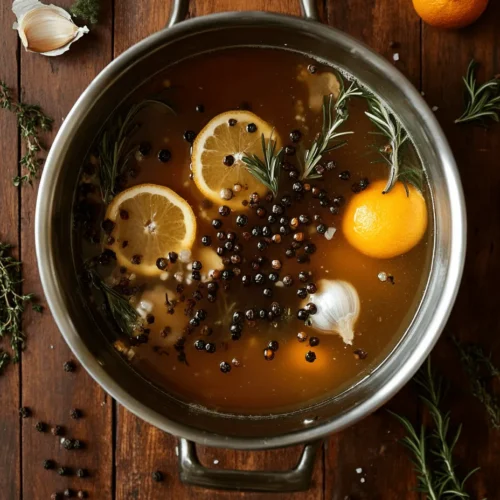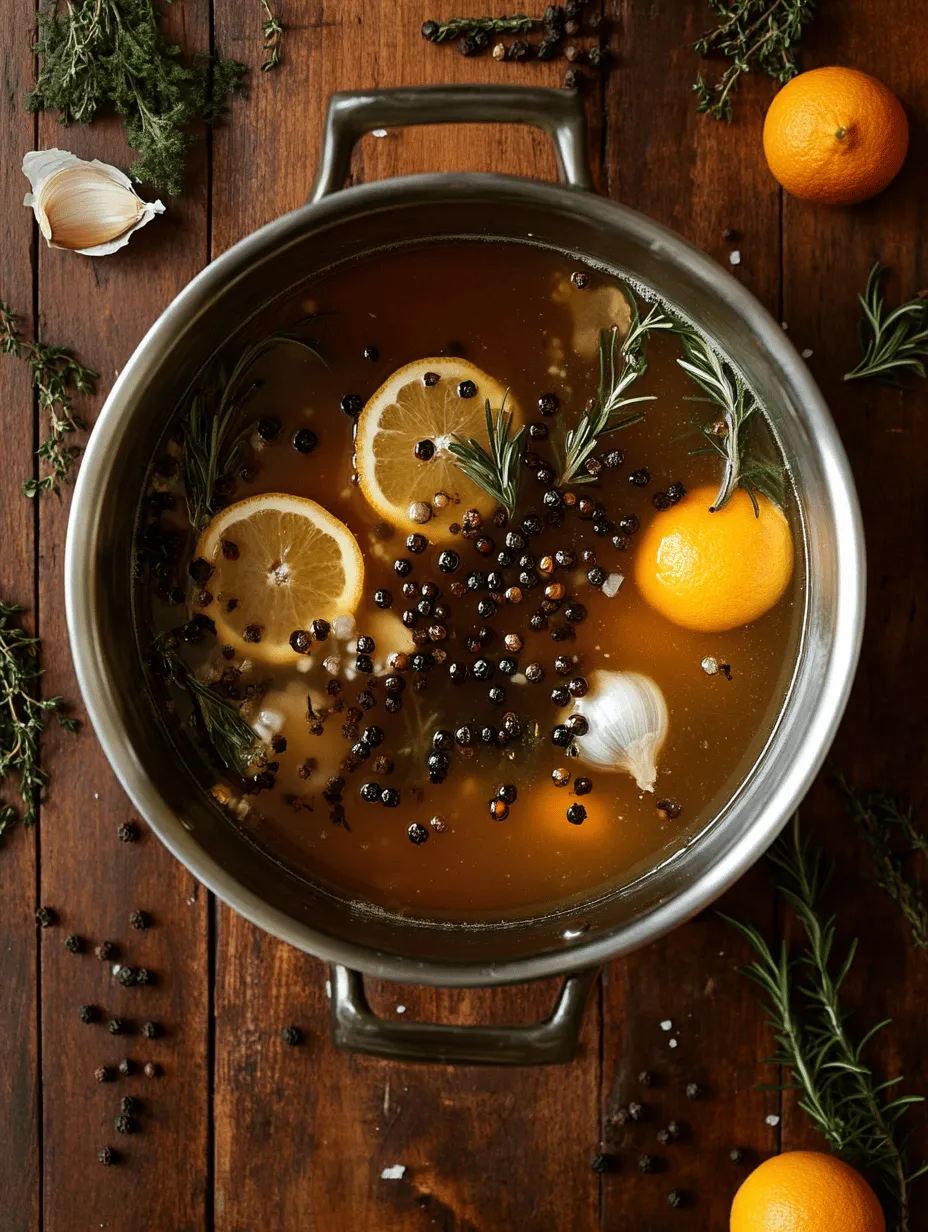Introduction
When it comes to preparing the perfect turkey, brining is an essential technique that many home cooks and chefs swear by. The significance of brining in turkey preparation cannot be overstated; it’s a game-changer that transforms an ordinary bird into a succulent centerpiece for your holiday table. By immersing your turkey in a flavorful brine, you can enhance both its flavor and moisture content, ensuring that every bite is tender and juicy.
This article introduces you to our Savory Herbal Turkey Brine recipe, a delightful blend of herbs and spices that will infuse your turkey with aromatic flavors. Whether you’re hosting a Thanksgiving dinner, a festive holiday gathering, or any special occasion, this brine will ensure your turkey stands out as the star of the meal. Let’s explore the fascinating world of turkey brining and get started on creating your own batch of savory herbal brine.
Understanding the Basics of Turkey Brining
What is Brining?
Brining is the process of soaking meat in a solution of water, salt, and other flavor-enhancing ingredients. This technique serves multiple purposes: it not only seasons the meat but also helps it retain moisture during the cooking process. The salt in the brine penetrates the meat, breaking down protein structures and allowing for moisture to be absorbed and held within the turkey. The result? A bird that is juicy, flavorful, and simply irresistible.
How Brining Works
The science behind brining lies primarily in the interaction between salt, sugar, and the proteins in the turkey. When the turkey is submerged in the brine, the salt begins to dissolve in the water, creating a solution that can permeate the meat. This process causes the turkey to absorb the brine, which enhances its flavor and moisture content. In addition to salt, sugar is often included in brines for its ability to counterbalance the saltiness and add a subtle sweetness that rounds out the flavors.
The Role of Salt and Sugar
Salt serves as the primary flavor enhancer in a brine. It not only seasons the turkey but also helps denature proteins, allowing the meat to retain moisture during cooking. The sugar in the brine plays a crucial role in balancing the saltiness, adding an extra layer of flavor while also promoting browning during the cooking process. Together, these two ingredients work harmoniously to ensure that your turkey is not just flavorful, but also moist and tender.
Ingredients Breakdown
Now that we understand the benefits of brining and the science behind it, let’s take a closer look at the ingredients used in our Savory Herbal Turkey Brine. Each component has been carefully selected to create a well-rounded flavor profile that complements the natural taste of the turkey.
Water
As the foundation of the brine, water is essential for dissolving the salt and sugar while also allowing the brine to be absorbed into the turkey. Using cold water is recommended, as it helps to keep the turkey at a safe temperature during the brining process.
Kosher Salt
Kosher salt is the star ingredient in any brine. Its larger granules are perfect for dissolving in water, making it easy to create a brine that evenly seasons the turkey. Additionally, kosher salt has a clean flavor and is less salty than table salt, ensuring that your turkey won’t end up overly salty.
Brown Sugar
Brown sugar adds a touch of sweetness to the brine, balancing the saltiness and enhancing the overall flavor. The molasses content in brown sugar also contributes to a rich, complex taste that complements the savory elements of the brine.
Black Peppercorns, Allspice Berries, and Juniper Berries
These aromatic spices are key to adding depth to your brine. Black peppercorns contribute a mild heat, while allspice berries bring a warm, slightly sweet flavor reminiscent of cloves and nutmeg. Juniper berries offer a unique, piney note that pairs beautifully with turkey, enhancing its natural flavors.
Garlic, Rosemary, and Thyme
Fresh herbs play a crucial role in elevating the flavor of your brine. Garlic provides a robust, savory kick, while rosemary and thyme add a fragrant herbal quality. Together, these ingredients create a delightful bouquet that will permeate your turkey, infusing it with complex flavors.
Citrus Fruits (Orange and Lemon)
Citrus fruits like orange and lemon introduce brightness and acidity to the brine, cutting through the richness of the turkey. Their zest and juice not only enhance the flavor but also bring a refreshing element that balances the savory components of the brine.
Optional Crushed Red Pepper Flakes
For those who enjoy a hint of heat, crushed red pepper flakes can be added to the brine. This optional ingredient will introduce a subtle spiciness that contrasts with the other flavors, adding an exciting twist to your turkey.
Preparation Steps for the Savory Herbal Turkey Brine
Creating your Savory Herbal Turkey Brine is a straightforward process that involves just a few simple steps. Follow this step-by-step guide to ensure you achieve the perfect brine for your turkey.
Step 1: Combine Ingredients
In a large pot, combine the water, kosher salt, and brown sugar. Stir the mixture over medium heat until the salt and sugar are completely dissolved. This step is crucial, as undissolved salt or sugar can lead to uneven seasoning in your turkey.
Step 2: Add Aromatics
Once the salt and sugar are dissolved, remove the pot from heat. Add the black peppercorns, allspice berries, juniper berries, minced garlic, chopped rosemary, and thyme to the pot. Stir well to combine all the aromatic ingredients with the brine.
Step 3: Incorporate Citrus
Next, add the juice and zest of the orange and lemon to the brine mixture. The citrus will add a refreshing element to the overall flavor profile. For an extra kick, sprinkle in the crushed red pepper flakes if desired.
Step 4: Cool the Brine
Allow the brine to cool to room temperature before using it to brine your turkey. You can expedite this process by placing the pot in an ice bath or refrigerating it. It’s essential to ensure the brine is cool to prevent cooking the turkey when it’s added.
Step 5: Brine the Turkey
Once the brine has cooled, it’s time to submerge your turkey. Place the turkey in a large container or brining bag, and pour the brine over the bird, ensuring it is fully submerged. If necessary, weigh down the turkey with a plate or use a brining weight to keep it submerged.
Step 6: Refrigerate
Cover the container or seal the brining bag and refrigerate the turkey for at least 12 hours, but no more than 24 hours. The longer the turkey brines, the more flavor it will absorb, but be cautious not to exceed this timeframe, as it can lead to an overly salty turkey.
By following these preparation steps for your Savory Herbal Turkey Brine, you’re well on your way to creating a deliciously moist and flavorful turkey that will impress your family and friends. Stay tuned for the next part of our article, where we’ll delve deeper into tips for the perfect brining process and how to cook your turkey to perfection.

Cooling Process and the Significance of Temperature in Brining
After preparing your savory herbal turkey brine, it’s crucial to let it cool properly before introducing your turkey. A brine that is too warm can raise the temperature of the turkey, creating an unsafe environment for bacteria to flourish. Ideally, once your brine has been mixed, you should place it in the refrigerator until it reaches room temperature or cooler, preferably below 40°F (4°C). This cooling process not only ensures food safety but also allows the flavors of the herbs and spices to infuse into the liquid, enhancing the overall taste profile of the brine.
How to Effectively Submerge the Turkey and Ensure Even Brining
To achieve the best results, you must ensure that the turkey is fully submerged in the brine. Use a large, food-safe container or a brining bag designed for this purpose. If using a container, make sure it is deep enough to hold the turkey while completely covering it with the brine. If you opt for a brining bag, place the turkey inside, pour the cooled brine over it, and seal the bag tightly, ensuring there are no air pockets.
To help the turkey stay submerged, you can weigh it down with a plate or a heavy-duty zip-top bag filled with brine. This ensures that every surface of the turkey is in contact with the brine, promoting even absorption. It’s also essential to turn the turkey occasionally during the brining process to ensure all parts receive equal treatment from the brine.
The Impact of Brining Duration
Recommended Brining Times (12 to 24 Hours)
The duration of brining significantly impacts flavor absorption and moisture retention. For a well-balanced flavor, it’s recommended to brine your turkey for a minimum of 12 hours, but up to 24 hours is ideal for maximum flavor and juiciness. The longer the turkey sits in the brine, the more it absorbs the flavors of the herbs and spices, resulting in a turkey that is not only tastier but also retains more moisture during cooking.
How Different Durations Affect Flavor Absorption and Moisture Retention
– 12 Hours: This duration is sufficient for a mild flavor enhancement and slight moisture improvement. It’s suitable for smaller turkeys or if you’re short on time.
– 18 Hours: A sweet spot for flavor and moisture, this duration allows the herbs to penetrate deeper while still being manageable for preparation.
– 24 Hours: For larger birds or when you want maximum flavor and juiciness, brining for a full day is recommended. It allows the brine to work its magic fully, resulting in a turkey that is succulent and bursting with flavor.
Safety Considerations When Brining Turkey
While brining is an excellent way to enhance your turkey, safety should always be a priority. Ensure that your turkey is kept at a safe temperature during the brining process, ideally below 40°F (4°C). If you’re brining in a cooler, pack it with ice to maintain a low temperature, especially during warmer months. Never leave your turkey to brine at room temperature, as this can lead to bacterial growth and foodborne illnesses.
Culinary Uses Beyond Turkey
Creative Ways to Use Leftover Brine for Other Proteins
Don’t let your flavorful brine go to waste! It can be repurposed for other proteins, providing a delicious marinade for chicken, pork, or even vegetables. Just remember to adjust the brining times based on the size and type of protein. For instance, chicken breasts may only need a few hours, whereas pork loins might benefit from a longer brining period similar to turkey.
Suggestions for Brining Chicken, Pork, or Vegetables Using the Same Method
– Chicken: Use the same brine for chicken, adjusting the time to 2-6 hours depending on the cut. This method works particularly well for chicken thighs and drumsticks, resulting in juicy and flavorful meat.
– Pork: A pork loin or chops can be brined for up to 12 hours in the same savory brine. The flavor pairs well with the natural sweetness of pork.
– Vegetables: Consider brining vegetables like carrots, radishes, or cucumbers for a unique side dish. A shorter brining time (about 30 minutes to 2 hours) will infuse a subtle flavor without overpowering the veggies.
Tips on Adjusting Flavors for Different Meats
When using leftover brine for different proteins, consider tweaking the flavor profile slightly to suit the meat. For example, adding citrus zest for chicken or a bit of brown sugar for pork can enhance the natural flavors of the proteins. Don’t hesitate to experiment with additional spices or herbs to create unique variations of your brine for different dishes.
Cooking the Brined Turkey
Once your turkey has completed the brining process, it’s time to cook it to perfection. There are several cooking methods you can choose from, each offering a unique flavor and texture profile.
Overview of Cooking Methods Post-Brining (Roasting, Smoking, Grilling)
– Roasting: The most common method, roasting allows for crispy skin and juicy meat. Preheat your oven to 325°F (163°C) and roast the turkey until the internal temperature reaches 165°F (74°C). Basting occasionally will help keep the meat moist.
– Smoking: This method infuses the turkey with a rich, smoky flavor. Maintain a consistent temperature of 225-250°F (107-121°C) in your smoker and cook until the internal temperature is reached. Wood chips can be selected based on your flavor preference, such as hickory for a strong smoke or applewood for a sweeter touch.
– Grilling: A more adventurous approach, grilling your turkey can yield a wonderful char and flavor. Use indirect heat to prevent the outside from burning while allowing the inside to cook thoroughly. Aim for a temperature of around 350°F (177°C) on the grill.
Importance of Rinsing and Drying the Turkey Before Cooking
Before cooking, it’s important to rinse the turkey under cold water to remove excess salt from the brining process. This step helps prevent an overly salty outcome. After rinsing, pat the turkey dry with paper towels, which is essential for achieving crispy skin during cooking. Moisture on the skin can lead to steaming rather than roasting.
Recommendations for Seasoning and Cooking Temperatures
While the brine imparts flavor, you can enhance the dish further with additional seasonings. A simple mixture of olive oil, garlic, and herbs can be rubbed under the skin and on the surface. For roasting, aim for an oven temperature of approximately 325°F (163°C) to ensure even cooking. For smoking, maintain a temperature of about 225°F (107°C) for a longer cook time that allows the flavors to develop fully.
Pairing Suggestions for Brined Turkey
To complement your savory herbal brined turkey, consider pairing it with side dishes that enhance the flavors while providing a well-rounded meal experience.
Recommended Side Dishes and Flavor Profiles that Complement the Savory Brined Turkey
– Stuffing: A classic turkey side dish, stuffing made with herbs, sausage, and seasonal vegetables will pair beautifully with the brined turkey.
– Vegetable Medley: Roasted seasonal vegetables such as Brussels sprouts, carrots, and sweet potatoes provide a colorful and nutritious side.
– Cranberry Sauce: A sweet and tart cranberry sauce balances the savory flavors of the turkey, enhancing the overall meal.
Wine Pairings that Enhance the Meal Experience
When it comes to wine pairings, consider options that complement the savory and herbal notes of your turkey. A medium-bodied white wine, such as Chardonnay or Sauvignon Blanc, can enhance the flavors without overpowering them. Alternatively, a light red wine like Pinot Noir can also pair beautifully, offering a nice balance to the richness of the turkey.
Seasonal Vegetables and Salads that Work Well with Turkey
Incorporate seasonal flavors by adding a fresh salad with mixed greens, nuts, and a vinaigrette. Incorporating root vegetables or autumnal salads with apples and cranberries can enhance the festive feel of your meal.
Conclusion
In summary, using the Savory Herbal Turkey Brine is a transformative technique that elevates your turkey to new heights of flavor and juiciness. The careful balance of herbs and spices enhances the natural taste of the turkey while ensuring it remains moist throughout the cooking process.
Don’t hesitate to experiment with different flavors and techniques in your brining, and remember that the culinary journey is as much about sharing delicious meals with loved ones as it is about the food itself. So gather your friends and family, prepare your brined turkey, and enjoy the joy of cooking and sharing a flavorful meal together.



